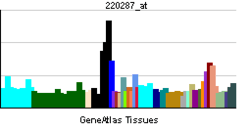ADAMTS9
| ADAM metallopeptidase with thrombospondin type 1 motif, 9 | |||||||||||||
|---|---|---|---|---|---|---|---|---|---|---|---|---|---|
| Identifiers | |||||||||||||
| Symbols | ADAMTS9 ; FLJ42955; KIAA1312 | ||||||||||||
| External IDs | OMIM: 605421 HomoloGene: 18821 IUPHAR: 1682 GeneCards: ADAMTS9 Gene | ||||||||||||
| |||||||||||||
| RNA expression pattern | |||||||||||||
 | |||||||||||||
| More reference expression data | |||||||||||||
| Orthologs | |||||||||||||
| Species | Human | Mouse | |||||||||||
| Entrez | 56999 | 101401 | |||||||||||
| Ensembl | ENSG00000163638 | ENSMUSG00000030022 | |||||||||||
| UniProt | Q9P2N4 | n/a | |||||||||||
| RefSeq (mRNA) | NM_182920 | NM_175314 | |||||||||||
| RefSeq (protein) | NP_891550 | NP_780523 | |||||||||||
| Location (UCSC) | Chr 3: 64.5 – 64.67 Mb | Chr 6: 92.77 – 92.94 Mb | |||||||||||
| PubMed search | |||||||||||||
A disintegrin and metalloproteinase with thrombospondin motifs 9 is an enzyme that in humans is encoded by the ADAMTS9 gene.[1][2]
This gene encodes a member of the ADAMTS (a disintegrin and metalloproteinase with thrombospondin motifs) protein family. Members of the family share several distinct protein modules, including a propeptide region, a metalloproteinase domain, a disintegrin-like domain, and a thrombospondin type 1 (TS) motif. Individual members of this family differ in the number of C-terminal TS motifs, and some have unique C-terminal domains. Members of the ADAMTS family have been implicated in the cleavage of proteoglycans, the control of organ shape during development, and the inhibition of angiogenesis. This gene is localized to chromosome 3p14.3-p14.2, an area known to be lost in hereditary renal tumors.[2]
References
- ↑ Clark ME, Kelner GS, Turbeville LA, Boyer A, Arden KC, Maki RA (Sep 2000). "ADAMTS9, a novel member of the ADAM-TS/ metallospondin gene family". Genomics 67 (3): 343–50. doi:10.1006/geno.2000.6246. PMID 10936055.
- ↑ 2.0 2.1 "Entrez Gene: ADAMTS9 ADAM metallopeptidase with thrombospondin type 1 motif, 9".
Further reading
- Tang BL (2001). "ADAMTS: a novel family of extracellular matrix proteases.". Int. J. Biochem. Cell Biol. 33 (1): 33–44. doi:10.1016/S1357-2725(00)00061-3. PMID 11167130.
- Nagase T, Kikuno R, Ishikawa KI et al. (2000). "Prediction of the coding sequences of unidentified human genes. XVI. The complete sequences of 150 new cDNA clones from brain which code for large proteins in vitro.". DNA Res. 7 (1): 65–73. doi:10.1093/dnares/7.1.65. PMID 10718198.
- Strausberg RL, Feingold EA, Grouse LH et al. (2003). "Generation and initial analysis of more than 15,000 full-length human and mouse cDNA sequences.". Proc. Natl. Acad. Sci. U.S.A. 99 (26): 16899–903. doi:10.1073/pnas.242603899. PMC 139241. PMID 12477932.
- Somerville RP, Longpre JM, Jungers KA et al. (2003). "Characterization of ADAMTS-9 and ADAMTS-20 as a distinct ADAMTS subfamily related to Caenorhabditis elegans GON-1.". J. Biol. Chem. 278 (11): 9503–13. doi:10.1074/jbc.M211009200. PMID 12514189.
- Ota T, Suzuki Y, Nishikawa T et al. (2004). "Complete sequencing and characterization of 21,243 full-length human cDNAs.". Nat. Genet. 36 (1): 40–5. doi:10.1038/ng1285. PMID 14702039.
- Cross NA, Chandrasekharan S, Jokonya N et al. (2005). "The expression and regulation of ADAMTS-1, -4, -5, -9, and -15, and TIMP-3 by TGFbeta1 in prostate cells: relevance to the accumulation of versican.". Prostate 63 (3): 269–75. doi:10.1002/pros.20182. PMID 15599946.
- Zeng W, Corcoran C, Collins-Racie LA et al. (2006). "Glycosaminoglycan-binding properties and aggrecanase activities of truncated ADAMTSs: comparative analyses with ADAMTS-5, -9, -16 and -18.". Biochim. Biophys. Acta 1760 (3): 517–24. doi:10.1016/j.bbagen.2006.01.013. PMID 16507336.
- Koo BH, Longpré JM, Somerville RP et al. (2006). "Cell-surface processing of pro-ADAMTS9 by furin.". J. Biol. Chem. 281 (18): 12485–94. doi:10.1074/jbc.M511083200. PMID 16537537.
- Lo PH, Leung AC, Kwok CY et al. (2007). "Identification of a tumor suppressive critical region mapping to 3p14.2 in esophageal squamous cell carcinoma and studies of a candidate tumor suppressor gene, ADAMTS9.". Oncogene 26 (1): 148–57. doi:10.1038/sj.onc.1209767. PMID 16799631.
External links
| |||||||||||||||||||||